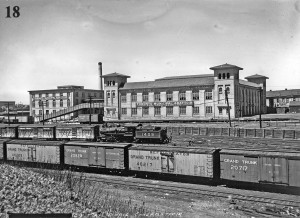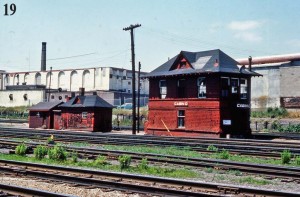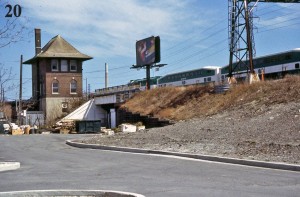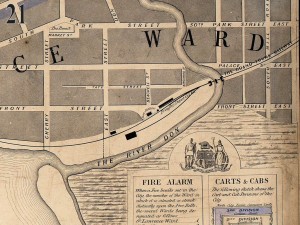Railway Heritage Footprints in the West Donlands – Part 3 of 6
 Click on each image for a closer look!
Click on each image for a closer look!
Concerns over the hygienic preparation of meat products at other smaller slaughterhouses encouraged the City of Toronto to establish the Municipal Abattoir just west of Bathurst Street in 1914. IMAGE #18 shows this facility looking north from the Fort York ramparts. The photograph is also interesting in that it shows the two types of railway cars that were essential to the meat industry. The livestock was transported into the city in the stock cars (basically ventilated boxcars) in front of the locomotive while the dressed meat was delivered in the refrigerated cars in the foreground. The abattoir was also notable in that it was located close to original location of the railway interlocking tower known as Cabin D and the abattoir building can be seen in greatly modified form above the tool s hed in IMAGE #19 (courtesy of Doug Wilson). Both wooden structures have been relocated and restored at the Toronto Railway Heritage Centre. By the 1920’s, the municipal meat packing industry had relocated to West Toronto, where it remained until the 1980’s, when the railways finally gave up on the logistically complicated and messy transportation of livestock.
hed in IMAGE #19 (courtesy of Doug Wilson). Both wooden structures have been relocated and restored at the Toronto Railway Heritage Centre. By the 1920’s, the municipal meat packing industry had relocated to West Toronto, where it remained until the 1980’s, when the railways finally gave up on the logistically complicated and messy transportation of livestock.
Returni ng to the West Donlands and the 1924 map, the red lines indicate tracks that would soon be built for the Waterfront Grade Separation. The small building that can just be made out south of Queen Street between the tracks and the Don River is the Canadian Pacific Railway Don Station, now restored at the Toronto Railway Heritage Centre. Not shown on the map, because it wasn’t built until 1930, is the current Cherry Street interlocking tower of the Toronto Terminals Railway. (IMAGE #20) The tower is scheduled to be taken out of service in 2015 after GO Transit installs a new computerized interlocking system. Neither GO nor Waterfront Toronto has indicated what will become of the structure at that point.
ng to the West Donlands and the 1924 map, the red lines indicate tracks that would soon be built for the Waterfront Grade Separation. The small building that can just be made out south of Queen Street between the tracks and the Don River is the Canadian Pacific Railway Don Station, now restored at the Toronto Railway Heritage Centre. Not shown on the map, because it wasn’t built until 1930, is the current Cherry Street interlocking tower of the Toronto Terminals Railway. (IMAGE #20) The tower is scheduled to be taken out of service in 2015 after GO Transit installs a new computerized interlocking system. Neither GO nor Waterfront Toronto has indicated what will become of the structure at that point.
T he Don Yards east of the tower are currently used for the storage and servicing of GO Transit train sets. This was originally one of the oldest railway facilities in Toronto, built by the Grand Trunk Railway in 1855. IMAGE #21 is a segment of an 1857 map of this facility, which is somewhat confusing in that Palace Street is today Front Street and Front Street on the map is today Mill Street. A locomotive shop is shown on the map as a black rectangle above the word “RIVER.” This facility was used for the final assembly of engines purchased from the Toronto Locomotive Works (TLW) at Yonge and Queen streets. Following the TLW’s labourious delivery in 1853 (http://torontorha.blogspot.com/2009/06/railways-appeared-in-toronto-in-1852.html) of the first locomotive built in Canada through the streets of the city, the GTR decided it was easier to transport the boiler and other parts separately and carry out the final assembly of locomotives closer to the actual railway tracks.
he Don Yards east of the tower are currently used for the storage and servicing of GO Transit train sets. This was originally one of the oldest railway facilities in Toronto, built by the Grand Trunk Railway in 1855. IMAGE #21 is a segment of an 1857 map of this facility, which is somewhat confusing in that Palace Street is today Front Street and Front Street on the map is today Mill Street. A locomotive shop is shown on the map as a black rectangle above the word “RIVER.” This facility was used for the final assembly of engines purchased from the Toronto Locomotive Works (TLW) at Yonge and Queen streets. Following the TLW’s labourious delivery in 1853 (http://torontorha.blogspot.com/2009/06/railways-appeared-in-toronto-in-1852.html) of the first locomotive built in Canada through the streets of the city, the GTR decided it was easier to transport the boiler and other parts separately and carry out the final assembly of locomotives closer to the actual railway tracks.
The original Grand Trunk Railway Don Station (seen on the map at the foot of Beachell Street, not to be confused with the CPR Don Station a half kilometre to the north) was also at this location and was the Toronto terminal of the first GTR trains from Montreal in 1856. The GTR Western Division from Stratford terminated at Queen’s Wharf near the foot of Bathurst Street. Passengers traveling through Toronto were carried by horse-drawn omnibus between the two terminals until early in 1857, when the Grand Trunk built a right-of-way along the Esplanade and connected the two sections. After GTR built the first downtown Union Station in 1858, Don continued as an eastern suburban station until 1896, when the railway opened a new station at Queen and DeGrassi streets that later became known as Riverdale. By this time, the meandering course of the Don River shown in the 1857 map had been straightened, which permitted the building of railway tracks on the west side of the river.
Click here to read the next posting in this series.
Click here to return to the first posting in this series.
Posting by Derek Boles

